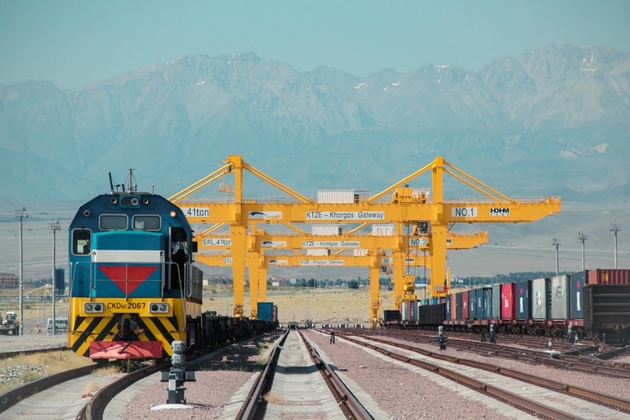Since early September, media in Caspian littoral countries have been filled with stories about the expansion of Chinese rail operations there, a development that represents a double challenge to Moscow. The experts of The Jamestown Foundation assume that this undermines Russia’s influence. Beijing is promoting container shipping carrying finished goods rather than bulk cargo, raising the regional countries’ economic dependence on China while further tipping the balance away from Russia, which relies far more on the export and transit of raw resources rather than products higher up the value chain. Many of these Chinese railroad projects have been in the works for several years. But now they are becoming operational, potentially leading to dramatic long-term economic, political and geopolitical consequences.
The Transportation-Logistics Center of Turkmenistan reported, on September 9, that the longest-ever container train would arrive in that country two days later from China, after a journey of only two weeks. This is a much shorter transit time than on any other route that was available until now. It will bring Chinese goods to Turkmenistan, other Central Asian countries as well as their Caspian littoral neighbors, Iran and Azerbaijan. Turkmenistani officials said that the 8,780-kilometer railroad would permit goods to move in both directions in only 12–15 days, making it the most timely and economically effective path for Chinese trade with Central Asia, the Caspian and even Europe.
China has invested heavily in improving the railroads in this region, although Russian officials stress that its activities only became possible thanks to Moscow’s North-South Transportation Corridor Project, which is intended to boost Russian exports of raw materials to Iran and India on a traversing Kazakhstan and Turkmenistan.
Nonetheless, China’s regional role is different and larger: it is sending consumer goods and other finished products that are more likely to find buyers in these countries than Russian raw materials, like oil and natural gas. Moreover, Beijing offers these countries the possibility of shipping some of their industrial production to the Chinese market, which is far larger and more interested in such purchases than Russia’s. Ashgabat contends that the freight train service with China will soon increase in frequency to twice a week. And as these trans-Eurasian container rail routes expand operation, they will inevitably draw the Caspian littoral countries closer into China’s orbit—and away from Russia’s—more powerfully than almost any other factor simultaneously at play in the region.
In a clear indication that China’s breakthrough in Turkmenistan is not a one-off development, the day after the Ashgabat report, Beijing announced it was opening another container rail link, this time with Azerbaijan. Beijing further noted that a container train had left China, would pass through Kazakhstan, and then go on (via the Caspian Sea) to Baku. Azerbaijani newspapers reported that this multimodal route was the 12th such path that China has designated as critical to the development of rail links between Asia and Europe.
The China Railway Shanghai Group, which operates this line to Baku, says that goods from China can now reach Azerbaijan in 15–18 days, approximately a third less than the time required for shipments via other routes (either through Russia or through Iran). The newly inaugurated railway corridor will lead to an expansion not only of bilateral trade between China and Azerbaijan but also boost China’s exports further on, to Europe. While Beijing undoubtedly is more interested in the latter than the former—Chinese-European trade will certainly be much larger—it is explicitly holding out the prospect that Azerbaijan will find an expanded market for its products in China. And that potential growth in bilateral trade with China is sure to have political consequences in Baku.
The time needed for trains to pass between China and the Caspian littoral could be reduced even further, perhaps by as much as four days, if not for the historical legacies of track gauge differences across Eurasia. Namely, at the border between China and the former Soviet republics, operators must change train wheel bases to deal with the fact that, since tsarist times, the Russian/Soviet authorities have laid tracks 1,520 millimeters apart, rather than the 1,435 millimeters used almost everywhere else. Russia sees this as protection against invasion; but it costs logistics firms money because it makes any rail route via the post-Soviet space several days longer in each direction.
Beijing has pressed Moscow to allow it to build new narrower gauge rails on Russian routes it hopes to use most often or to make arrangements for dual-width track on them. (This involves having international standard rails laid within the Russian-gauge tracks on the same roadbed.) Four years ago, Moscow agreed to the construction of track with that gauge between the Chinese border and a Russian port, which Chinese officials see as “a precedent” for the future. And now that China is expanding its rail traffic through Central Asia, it is likely to use its clout to secure either a change in the local railway gauge or, more likely, at least initially the construction of dual-width tracks.
That would make the Chinese-Caspian route even more profitable for both sides. But far more importantly, it would also represent a major delinking of the countries of Central Asia and the Caspian littoral from Moscow—the latest and most dramatic example of the way the railway wars of the 19th century are resuming in the 21st.






